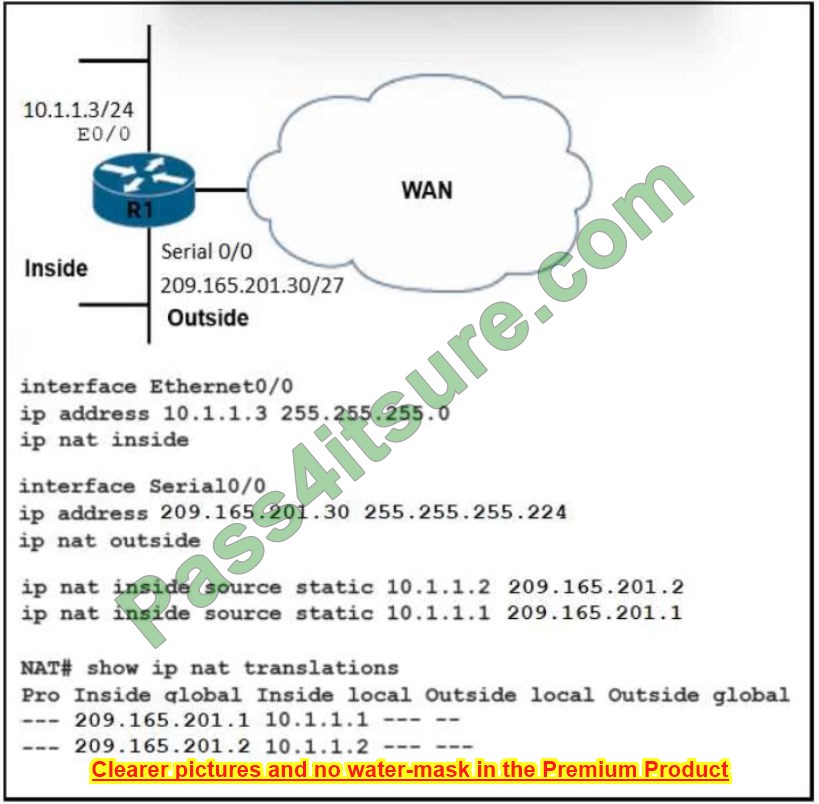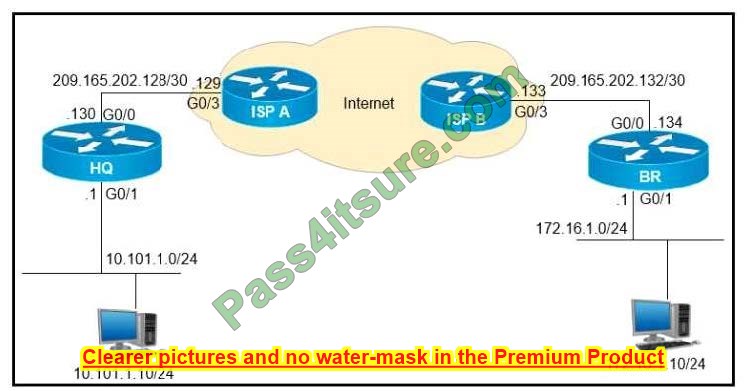
To get better career opportunities and higher salaries in the enterprise networking field, you must pass the CCNP 350-401 ENCOR exam. How do I win exams 350-401? Use the latest 350-401 ENCOR dumps.
Prepare for and take the exam with the Pass4itSure 350-401 ENCOR dumps and you can win the exam on your way.
Download the latest 350-401 ENCOR dumps here https://www.pass4itsure.com/350-401.html.
Why win the Cisco CCNP 350-401 exam?
- Obtained CCNP Enterprise Network Professional Certification.
- Improve your skills and knowledge to build a solid foundation for future career development.
- Helps you get better career opportunities and higher salaries in the corporate networking field.
How to successfully pass the 350-401 ENCOR exam?
As mentioned at the beginning, with the latest 350-401 ENCOR exam dumps, Pass4itSure is a great choice for you.
Win the exam with the latest 350-401 ENCOR dumps.
In addition to this, you must also take practice tests to improve your ability to take the Cisco 350-401 exam.
Don’t worry, we brought you free 350-401 exam questions that you can try.
Take the test: Latest 350-401 ENCOR dumps exam questions online
Question 1:
Which Quality of Service (QoS) mechanism allows the network administrator to control the maximum rate of traffic received or sent on a given interface?
A. Policing
B. Marking
C. Queueing
D. Classification
Correct Answer: A
Traffic Policing
In general, traffic policing allows you to control the maximum rate of traffic sent or received on an interface and to partition a network into multiple priority levels or classes of service (CoS).
Question 2:
What are the two benefits of YANG? (Choose two)
A. it collects statistical constraint analysis information
B. In enforces the use of specific encoding format for NETCONF
C. in enforces configuration semantics
D. it enables multiple leaf statements to exist within a leaf-list
E. it enforces configuration constraints
Correct Answer: BE
Question 3:
An engineer is concerned with the deployment of a new application that is sensitive to inter-packet delay variance. Which command configures the router to be the destination of jitter measurements?
A. Router(config)# ip sla responder udp-connect 172.29.139.134 5000
B. Router(config)# ip sla responder tcp-connect 172.29.139.134 5000
C. Router(config)# ip sla responder udp-echo 172.29.139.134 5000
D. Router(config)# ip sla responder tcp-echo 172.29.139.134 5000
Correct Answer: C
Cisco IOS IP SLA Responder is a Cisco IOS Software component whose functionality is to respond to Cisco IOS IP SLA request packets. The IP SLA source sends control packets before the operation starts to establish a connection to the
responder. Once the control packet is acknowledged, test packets are sent to the responder. The responder inserts a time stamp when it receives a packet and factors out the destination processing time and adds time stamps to the sent
packets. This feature allows the calculation of unidirectional packet loss, latency, and jitter measurements with the kind of accuracy that is not possible with ping or other dedicated probe testing.
Reference:
UDP Jitter measures the delay, delay variation (jitter), corruption, misordering and packet loss by generating periodic UDP traffic. This operation always requires IP SLA responder. The command to enable UDP Jitter Operation is “ip sla
responder udp-echo {destination-ip-address} [destination-port]
Question 4:
What is one primary REST security design principle?
A. fail-safe defaults
B. password hash
C. adding a timestamp in requests
D. OAuth
Correct Answer: A
Question 5:
Refer to the exhibit.

What are the two results of the NAT configuration? (Choose two.)
A. Packets with a destination of 200.1.1.1 are translated to 10.1.1.1 or .2. respectively.
B. A packet that is sent to 200.1.1.1 from 10.1.1.1 is translated to 209.165.201.1 on R1.
C. R1 looks at the destination IP address of packets entering S0/0 and destined for inside hosts.
D. R1 processes packets entering E0/0 and S0/0 by examining the source IP address.
E. R1 is performing NAT for inside addresses and outside addresses.
Correct Answer: BC
Question 6:
Refer to the exhibit.

Which configuration must be applied to the HQ router to set up a GRE tunnel between the HQ and BR routers?
A. interface Tunnel1 ip address 10.111.111.1 255.255.255.0 tunnel source GigabitEthernet0/0 tunnel destination 209.165.202.134
B. interface Tunnel1 ip address 10.111.111.1 255.255.255.0 tunnel source GigabitEthernet0/0 tunnel destination 209.165.202.129
C. interface Tunnel1 ip address 10.111.111.1 255.255.255.0 tunnel source GigabitEthernet0/0 tunnel destination 209.165.202.133
D. interface Tunnel1 ip address 10.111.111.1 255.255.255.252 tunnel source GigabitEthernet0/0 tunnel destination 209.165.202.129
Correct Answer: A
Question 7:
A new multicast server is being added to an existing PIM Sparse mode network. Which device in this network must the new server register with before its multicast traffic can be dispersed throughout the network?
A. IGMP Querier
B. Local PIM router
C. Local IGMP switch
D. Rendezvous Point (RP)
Correct Answer: D
Question 8:
Which LISP infrastructure device provides connectivity between non-sites and LISP sites by receiving non-LISP traffic with a LISP site destination?
A. PETR
B. PITR
C. map resolver
D. map server
Correct Answer: B
Proxy ingress tunnel router (PITR): answer \’PETR\’ PITR is an infrastructure LISP network entity that receives packets from non-LISP sites and encapsulates the packets to LISP sites or natively forwards them to non-LISP sites.
Reference: https://www.ciscopress.com/articles/article.asp?p=2992605 https://www.cisco.com/c/en/us/td/docs/solutions/Enterprise/Data_Center/DCI/5-0/LISPmobility/DCI_LISP_Host_Mobility/LISPmobile_2.html
Question 9:
Which device makes the decision for a wireless client to roam?
A. wireless client
B. wireless LAN controller
C. access point
D. WCS location server
Correct Answer: A
Question 10:
Which feature is supported by ElGRP but is not supported by OSPF?
A. route summarization
B. equal-cost load balancing
C. unequal-cost load balancing
D. route filtering
Correct Answer: C
Question 11:
Why would a log file contain a * next to the date?
A. The network device was receiving NTP time when the log messages were recorded
B. The network device was unable to reach the NTP server when the log messages were recorded.
C. The network device is not configured to use NTP
D. The network device is not configured to use NTP time stamps for logging.
Correct Answer: C
“Network device is not configured to use NTP” is the only answer which may justify the fact that the system clock has not been set and thus date and time are preceded by an asterisk (*),
Question 12:
What does Call Admission Control require the client to send in order to reserve the bandwidth?
A. SIP flow information
B. Wi-Fi multimedia
C. traffic specification
D. VoIP media session awareness
Correct Answer: C
Question 13:
What does the destination MAC on the outer MAC header identify in a VXLAN packet?
A. the emote spine
B. the next hop
C. the leaf switch
D. the remote switch
Correct Answer: B
Question 14:
DRAG DROP
Drag and drop the characteristics from the left onto the switching architectures on the right.
Select and Place:

Correct Answer:

Question 15:
What are two device roles in Cisco SD-Access fabric? (Choose two.)
A. core switch
B. vBond controller
C. edge node
D. access switch
E. border node
Correct Answer: CE
There are five basic device roles in the fabric overlay:
+
Control plane node: This node contains the settings, protocols, and mapping tables to provide the endpoint-to-location (EID-to-RLOC) mapping system for the fabric overlay. + Fabric border node: This fabric device (for example, core layer device) connects external Layer 3 networks to the SDA fabric.
+
Fabric edge node: This fabric device (for example, access or distribution layer device) connects wired endpoints to the SDA fabric.
+
Fabric WLAN controller (WLC): This fabric device connects APs and wireless endpoints to the SDA fabric.
+
Intermediate nodes: These are intermediate routers or extended switches that do not provide any sort of SD-Access fabric role other than underlay services.
Or you can download the latest 350-401 ENCOR exam questions pdf https://drive.google.com/file/d/1vd0-M9gbSw691vc5eBP_QxWBmCHD0xju/view?usp=share_link
Conclusion:
Arm yourself with the latest 350-401 ENCOR dumps to win the CCNP 350-401 exam, here, download more 350-401 exam questions: https://www.pass4itsure.com/350-401.html Struggle, come on.